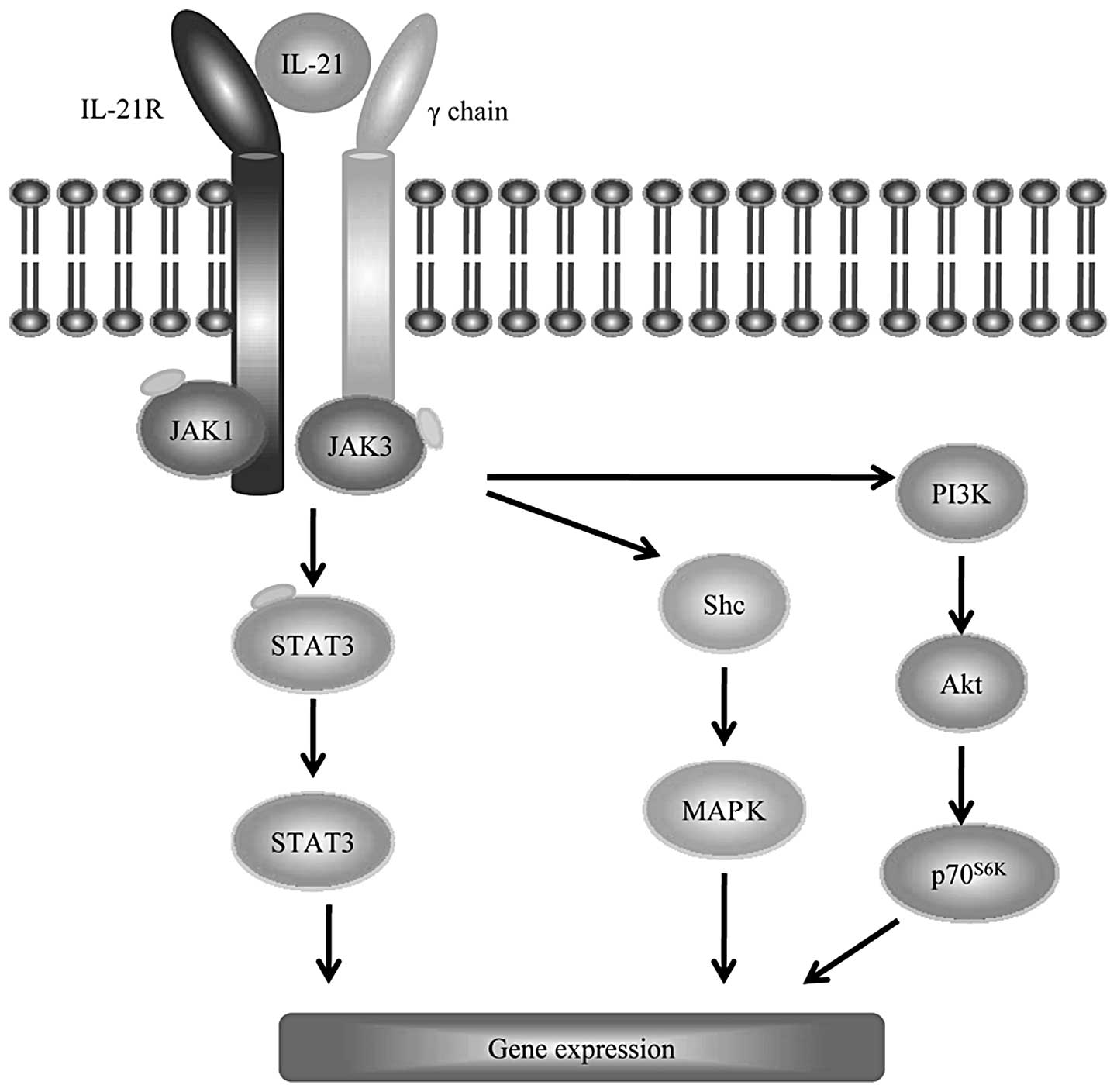|
1
|
Galli SJ, Tsai M and Piliponsky AM: The
development of allergic inflammation. Nature. 454:445–454. 2008.
View Article : Google Scholar : PubMed/NCBI
|
|
2
|
Caruso R, Botti E, Sarra M, et al:
Involvement of interleukin-21 in the epidermal hyperplasia of
psoriasis. Nat Med. 15:1013–1015. 2009. View Article : Google Scholar : PubMed/NCBI
|
|
3
|
Jin H, Oyoshi MK, Le Y, et al: IL-21R is
essential for epicutaneous sensitization and allergic skin
inflammation in humans and mice. J Clin Invest. 119:47–60.
2009.PubMed/NCBI
|
|
4
|
Hiromura Y, Kishida T, Nakano H, Hama T,
Imanishi J, Hisa Y and Mazda O: IL-21 administration into the
nostril alleviates murine allergic rhinitis. J Immunol.
179:7157–7165. 2007. View Article : Google Scholar : PubMed/NCBI
|
|
5
|
Chatterjee R, Batra J and Ghosh B: A
common exonic variant of interleukin 21 confers susceptibility to
atopic asthma. Int Arch Allergy Immunol. 148:137–146. 2009.
View Article : Google Scholar : PubMed/NCBI
|
|
6
|
Crotty S: Follicular helper CD4 T cells
(TFH). Annu Rev Immunol. 29:621–663. 2011. View Article : Google Scholar : PubMed/NCBI
|
|
7
|
Spolski R and Leonard WJ: Interleukin-21:
basic biology and implications for cancer and autoimmunity. Annu
Rev Immunol. 26:57–79. 2008. View Article : Google Scholar : PubMed/NCBI
|
|
8
|
Sarra M, Cupi ML, Pallone F and Monteleone
G: Interleukin-21 in immune and allergic diseases. Inflamm Allergy
Drug Targets. 11:313–319. 2012. View Article : Google Scholar : PubMed/NCBI
|
|
9
|
Zeng R, Spolski R, Casas E, Zhu W, Levy DE
and Leonard WJ: The molecular basis of IL-21-mediated
proliferation. Blood. 109:4135–4142. 2007. View Article : Google Scholar : PubMed/NCBI
|
|
10
|
Ozaki K, Spolski R, Feng CG, et al: A
critical role for IL-21 in regulating immunoglobulin production.
Science. 298:1630–1634. 2002. View Article : Google Scholar : PubMed/NCBI
|
|
11
|
Mehta DS, Wurster AL, Whitters MJ, Young
DA, Collins M and Grusby MJ: IL-21 induces the apoptosis of resting
and activated primary B cells. J Immunol. 170:4111–4118. 2003.
View Article : Google Scholar : PubMed/NCBI
|
|
12
|
Jin H, Carrio R, Yu A and Malek TR:
Distinct activation signals determine whether IL-21 induces B cell
costimulation, growth arrest, or Bim-dependent apoptosis. J
Immunol. 173:657–665. 2004. View Article : Google Scholar : PubMed/NCBI
|
|
13
|
Suto A, Nakajima H, Hirose K, et al:
Interleukin 21 prevents antigen-induced IgE production by
inhibiting germ line Cɛ transcription of IL-4-stimulated B cells.
Blood. 100:4565–4573. 2002.PubMed/NCBI
|
|
14
|
Harada M, Magara-Koyanagi K, Watarai H, et
al: IL-21-induced Bɛ cell apoptosis mediated by natural killer T
cells suppresses IgE responses. J Exp Med. 203:2929–2937. 2006.
|
|
15
|
Kishida T, Hiromura Y, Shin-Ya M, et al:
IL-21 induces inhibitor of differentiation 2 and leads to complete
abrogation of anaphylaxis in mice. J Immunol. 179:8554–8561. 2007.
View Article : Google Scholar : PubMed/NCBI
|
|
16
|
Small P and Kim H: Allergic rhinitis.
Allergy Asthma Clin Immunol. 7(Suppl 1): S32011. View Article : Google Scholar
|
|
17
|
Huang X, Yang Q, Chen Y, Li P, Zhang G and
Li Y: Expressions of IL-17, IL-21 and IL-23 in the serum of
allergic rhinitis patients. J Med Biochem. 30:323–327. 2011.
View Article : Google Scholar
|
|
18
|
Hayashida S, Uchi H, Moroi Y and Furue M:
Decrease in circulating Th17 cells correlates with increased levels
of CCL17, IgE and eosinophils in atopic dermatitis. J Dermatol Sci.
61:180–186. 2011. View Article : Google Scholar : PubMed/NCBI
|
|
19
|
Bieber T: Atopic dermatitis. N Engl J Med.
358:1483–1494. 2008. View Article : Google Scholar : PubMed/NCBI
|
|
20
|
Lin SC, Chuang YH, Yang YH and Chiang BL:
Decrease in interleukin-21 in children suffering with severe atopic
dermatitis. Pediatr Allergy Immunol. 22:869–875. 2011. View Article : Google Scholar : PubMed/NCBI
|
|
21
|
Wenzel SE: Asthma phenotypes: the
evolution from clinical to molecular approaches. Nat Med.
18:716–725. 2012. View
Article : Google Scholar : PubMed/NCBI
|
|
22
|
Fröhlich A, Marsland BJ, Sonderegger I,
Kurrer M, Hodge MR, Harris NL and Kopf M: IL-21 receptor signaling
is integral to the development of Th2 effector responses in vivo.
Blood. 109:2023–2031. 2007.PubMed/NCBI
|










